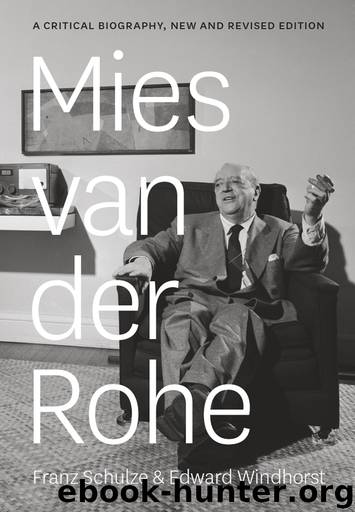Mies van der Rohe: A Critical Biography, New and Revised Edition by Franz Schulze & Edward Windhorst

Author:Franz Schulze & Edward Windhorst
Language: eng
Format: epub
Publisher: University of Chicago Press
Published: 2012-03-21T16:00:00+00:00
FIGURE 10.2. Farnsworth House, Plano, Illinois (1951); partial elevation view looking north from the banks of the Fox River.
With the Farnsworth House, Mies brought his American structural vocabulary to ultimate refinement. The house is a glass-walled rectangular prism supported above grade so as to clear the level of occasional floods. The long side faces north to a grassy rise, the south to the wooded riverbank. The roof and floor are bounded by fifteen-inch-deep steel channels turned flat side out, supported on each long side by four steel columns welded to these channels. (The W8 × 48 columns, nearly square in section, are usually used for steel foundations.)35 The exterior between floor and roof is, with the exception of a pair of glass doors and two hopper windows, quarter-inch-thick polished plate glass. The main floor area is 2,216 square feet, but only 1,540 are enclosed, with the remainder a porch.
Access is by a steel stair with travertine treads at the river side of the expansive terrace. (A second stair on the north was eliminated to save money.) The terrace lies parallel to the house but slides to the west, and is carried above grade at about half the height of the main floor. Another stair ascends from terrace to porch, where a right turn is required for entry through a pair of glass doors located close to the middle of the west wall.
The major element of the interior is a freestanding, asymmetrically placed core containing a galley kitchen, two bathrooms separated by a utility space, and a generous fireplace. A freestanding wardrobe suggests a sleeping area. The “living room,” which spreads before the fireplace with a view to the river, is similarly suggested. Cross ventilation can be conjured by opening the doors and the two hopper windows, the latter located at the base of the east wall opposite the entry. Originally, there was no air-conditioning—the house was mechanically ventilated by four concealed fans, including a whole-house exhaust fan sandwiched into the floor below the sink.
The stone floor is laid out on a 24-by-33-inch rectangular grid. It acts as a radiator for under-floor heating tubes, and conceals plumbing and electrical service to the kitchen, bathrooms, and utility space. A shaft from the core extends to the ceiling, accommodating exhaust from the heaters, kitchen, and baths as well as the roof drain. This drain, together with plumbing and electrical service, descends into a stack, painted black, which except for the columns is the only connection between house and ground.
Structure and space reflect the evolving preoccupations of Mies’s American years. What remained from the European career was the plan asymmetry, evident in the major elements of porch and terrace, and in the placement and programmatic uses of the core. Roman travertine, Mies’s ideal material for an important space, is used for both interior floors and exterior decking—a powerful unification of interior and exterior. Mies personally selected the travertine slabs and the veneer flitches for the millwork. The steel structure, made unitary by welded and
Download
This site does not store any files on its server. We only index and link to content provided by other sites. Please contact the content providers to delete copyright contents if any and email us, we'll remove relevant links or contents immediately.
| Actors & Entertainers | Artists, Architects & Photographers |
| Authors | Composers & Musicians |
| Dancers | Movie Directors |
| Television Performers | Theatre |
Cecilia; Or, Memoirs of an Heiress — Volume 3 by Fanny Burney(30928)
Cecilia; Or, Memoirs of an Heiress — Volume 2 by Fanny Burney(30885)
Fanny Burney by Claire Harman(25778)
We're Going to Need More Wine by Gabrielle Union(18065)
Plagued by Fire by Paul Hendrickson(16630)
Cat's cradle by Kurt Vonnegut(13856)
Bombshells: Glamour Girls of a Lifetime by Sullivan Steve(13101)
All the Missing Girls by Megan Miranda(12739)
Leonardo da Vinci by Walter Isaacson(11896)
4 3 2 1: A Novel by Paul Auster(11034)
Adultolescence by Gabbie Hanna(8137)
The remains of the day by Kazuo Ishiguro(7542)
Note to Self by Connor Franta(7022)
Diary of a Player by Brad Paisley(6864)
Giovanni's Room by James Baldwin(5871)
What Does This Button Do? by Bruce Dickinson(5519)
Recovery by Russell Brand(4559)
Born a Crime by Trevor Noah(4507)
The Kite Runner by Khaled Hosseini(4416)
